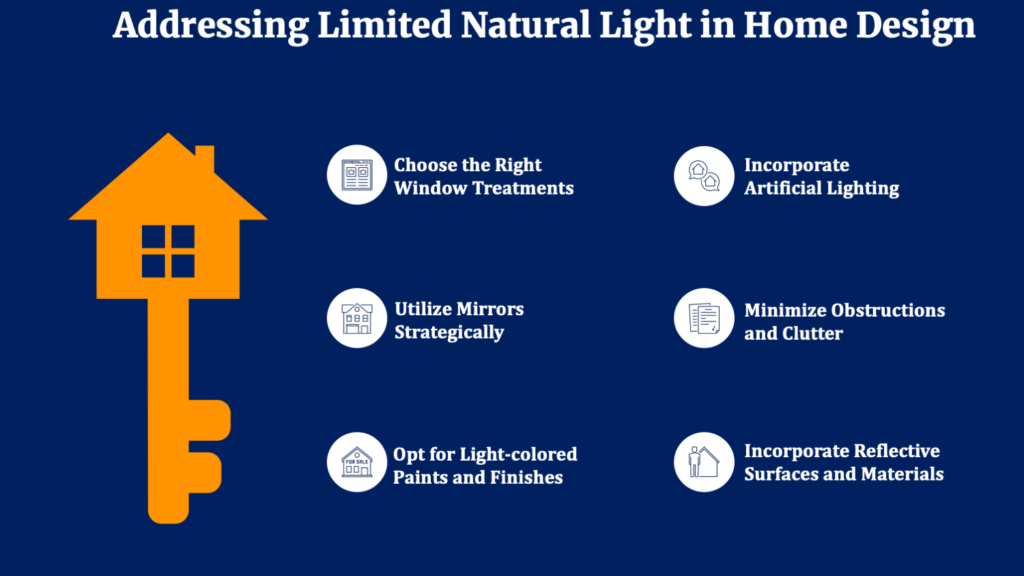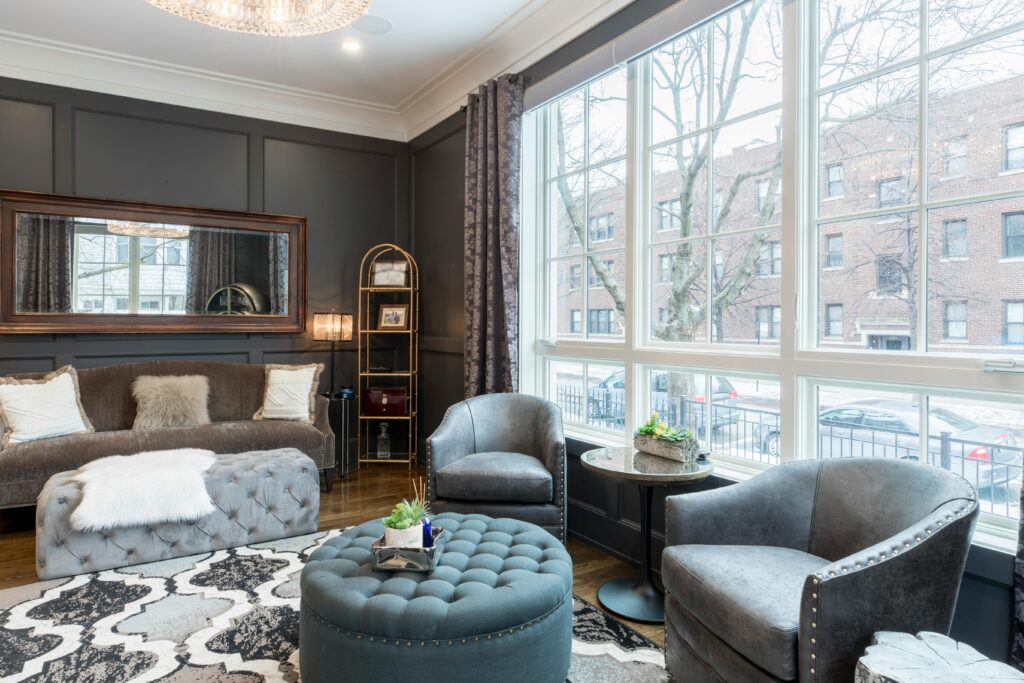To Share is to Show You Care!
When it comes to creating a welcoming and vibrant living space, natural light plays an indispensable role. However, not every home boasts ample windows or sunlit corners. If you find yourself grappling with limited natural light in your home, don’t fret! There are plenty of creative and effective solutions to brighten up your space and enhance its aesthetic appeal.

1. Choose the Right Window Treatments
Sheer Curtains: Opt for lightweight and sheer curtains that allow maximum light penetration while maintaining privacy.
Vertical Blinds: These can be adjusted to control the amount of light entering the room, providing flexibility throughout the day.
Light-colored Fabrics: Choose curtains and blinds in light colors to reflect light and create an airy ambiance.
2. Utilize Mirrors Strategically
Large Mirrors: Place large mirrors opposite windows to reflect natural light and make the room appear larger.
Mirrored Furniture: Incorporate mirrored furniture pieces like coffee tables or dressers to amplify light and add a touch of elegance.
Mirror Tiles: Use mirror tiles as backsplashes in kitchens or as accents on walls to enhance light reflection.
3. Opt for Light-colored Paints and Finishes
White Walls: Paint walls in light shades of white or pastels to bounce light around the room and create a bright, open feel.
Glossy Finishes: Choose glossy or satin paint finishes that reflect light rather than absorbing it, adding luminosity to your interiors.
Light-colored Flooring: Opt for light-colored flooring materials like hardwood or light-toned tiles to further brighten the space.
4. Incorporate Artificial Lighting
Layered Lighting: Combine ambient, task, and accent lighting to create a well-lit and inviting atmosphere.
LED Lights: Use energy-efficient LED lights that mimic natural daylight to brighten dark corners and create a warm glow.
Light Fixtures: Choose light fixtures with transparent or glass shades to allow light to pass through freely and illuminate the space effectively.
5. Minimize Obstructions and Clutter
Open Shelving: Replace bulky cabinets with open shelving to create an airy and spacious look.
Low-profile Furniture: Opt for low-profile furniture pieces that do not obstruct the flow of light and maintain an open feel.
Declutter Regularly: Keep surfaces clean and organized to maximize the reflection of light and prevent shadows from forming.
6. Incorporate Reflective Surfaces and Materials
Glass Accents: Introduce glass vases, tabletops, or decorative objects to scatter light and add visual interest.
Metallic Finishes: Use metallic accents like brass, chrome, or copper to reflect light and create a glamorous ambiance.
High-gloss Furniture: Choose furniture with high-gloss finishes to enhance light reflection and add a modern touch to your decor.
Conclusion
Limited natural light in your home doesn’t have to be a design dilemma. By implementing these creative solutions, you can transform your space into a bright and inviting haven that radiates warmth and style. From choosing the right window treatments and paint colors to strategically placing mirrors and incorporating reflective surfaces, these tips will help you make the most of the available light and elevate your home decor to new heights.
Remember, a well-lit and beautifully decorated home not only enhances your mood but also creates a welcoming ambiance for family and friends. So, embrace these ideas and let your home shine brightly, even on the cloudiest days!
Frequently Asked Questions:
Q1: How does natural light affect interior design?
A: Natural light plays a pivotal role in interior design by influencing the mood, ambiance, and perceived size of a space. It can enhance the colors of furnishings and decor, create depth and shadows, and promote a sense of well-being and vitality. Additionally, natural light can reduce the need for artificial lighting during the day, leading to energy savings and sustainability.
Q2: How do you fix lack of natural light?
A: To address a lack of natural light in a space, consider the following solutions:
- Choose light-colored paints and finishes to reflect light.
- Opt for sheer curtains and vertical blinds to maximize light penetration.
- Use mirrors strategically to amplify light and create the illusion of space.
- Incorporate artificial lighting with layered and task-specific fixtures.
- Minimize obstructions and clutter to allow light to flow freely throughout the room.
Q3: What can lack of natural light cause?
A: A lack of natural light can lead to several issues, including:
- A gloomy and uninviting atmosphere.
- Reduced energy and productivity levels.
- Strained eyes and potential eye-related health problems.
- Discoloration or fading of furnishings and decor.
- Increased reliance on artificial lighting, leading to higher energy consumption.
Q4: What are the drawbacks to natural light?
A: While natural light offers numerous benefits, there are some drawbacks to consider:
- Potential for glare and excessive heat, requiring appropriate window treatments.
- Fading of furniture, flooring, and artwork due to UV exposure.
- Inconsistent light levels throughout the day, affecting mood and comfort.
- Privacy concerns, necessitating the use of blinds or shades.
Q5: Can a room have too much natural light?
A: Yes, a room can have too much natural light, which may result in:
- Glare and discomfort, requiring the use of window treatments or shades.
- Increased heat and UV exposure, leading to fading of furnishings and increased energy costs.
- Difficulty in maintaining consistent light levels for tasks and activities.
Q6: How important is natural light in a room?
A: Natural light is essential in a room as it:
- Enhances mood, well-being, and overall happiness.
- Creates a bright and welcoming ambiance.
- Highlights architectural features and design elements.
- Improves energy efficiency by reducing the need for artificial lighting.
- Promotes health by regulating circadian rhythms and vitamin D production.
Q7: How do you mimic daylight in a windowless room?
A: To mimic daylight in a windowless room, consider these strategies:
- Use full-spectrum LED bulbs that replicate natural sunlight.
- Paint walls and ceilings in light, neutral shades to brighten the space.
- Incorporate mirrors to reflect light and create the illusion of windows.
- Add artificial plants or light therapy lamps to simulate outdoor ambiance.
Q8: How do you make a windowless room less depressing?
A: To make a windowless room less depressing, try the following tips:
- Use bright, uplifting colors and patterns in decor and furnishings.
- Incorporate ample artificial lighting with adjustable brightness levels.
- Hang artwork and photographs that evoke positive emotions and memories.
- Introduce indoor plants or greenery to add life and freshness to the space.
- Opt for reflective surfaces and materials to enhance light diffusion.
Q9: How can I brighten my dark living room?
A: To brighten a dark living room, consider implementing these solutions:
- Paint walls in light colors or use wallpaper with bright patterns.
- Install overhead and task-specific lighting fixtures with adjustable brightness.
- Use mirrors strategically to reflect light and create the illusion of space.
- Replace heavy drapes with sheer curtains or vertical blinds to maximize natural light.
- Incorporate light-colored furniture, rugs, and decor to enhance brightness.
Q10: Is it bad to sit in a dark room all day?
A: Yes, sitting in a dark room all day can have negative effects on your physical and mental well-being. Lack of natural light can lead to vitamin D deficiency, disrupted circadian rhythms, decreased energy levels, and increased feelings of depression or anxiety.
Q11: Is it healthy to be in a dark room all day?
A: No, it is not healthy to be in a dark room all day. Exposure to natural light is essential for regulating circadian rhythms, promoting vitamin D production, boosting mood and energy levels, and maintaining overall health and well-being.
Q12: What does being in a dark room do to you?
A: Being in a dark room for extended periods can negatively impact your health and well-being by:
- Disrupting circadian rhythms and sleep patterns.
- Causing vitamin D deficiency due to lack of sunlight exposure.
- Increasing feelings of depression, anxiety, and lethargy.
- Straining eyes and potentially leading to eye-related health problems.
- Decreasing energy levels and overall productivity.
Q13: Why is natural light important in design?
A: Natural light is important in design because it:
- Enhances the aesthetic appeal and visual comfort of a space.
- Highlights architectural features and design elements.
- Improves energy efficiency by reducing the need for artificial lighting.
- Promotes health and well-being by regulating circadian rhythms and vitamin D production.
- Creates a bright and welcoming ambiance that enhances mood and productivity.
Q14: What are the pros and cons of natural light?
A:
Pros of Natural Light:
- Enhances mood and well-being.
- Highlights architectural features and design elements.
- Reduces energy costs by minimizing reliance on artificial lighting.
- Promotes health by regulating circadian rhythms and vitamin D production.
Cons of Natural Light:
- Potential for glare and excessive heat.
- Fading of furnishings, flooring, and artwork due to UV exposure.
- Inconsistent light levels throughout the day.
- Privacy concerns, necessitating the use of window treatments or shades.
Q15: What is considered natural light?
A: Natural light refers to the illumination provided by the sun during daylight hours. It includes direct sunlight, diffuse skylight, and reflected light from surfaces such as walls, floors, and ceilings. Natural light is characterized by its dynamic quality, varying intensity, and color temperature throughout the day, influencing the mood, ambiance, and visual perception of a space.
The Informed Minds
I'm Vijay Kumar, a consultant with 20+ years of experience specializing in Home, Lifestyle, and Technology. From DIY and Home Improvement to Interior Design and Personal Finance, I've worked with diverse clients, offering tailored solutions to their needs. Through this blog, I share my expertise, providing valuable insights and practical advice for free. Together, let's make our homes better and embrace the latest in lifestyle and technology for a brighter future.

